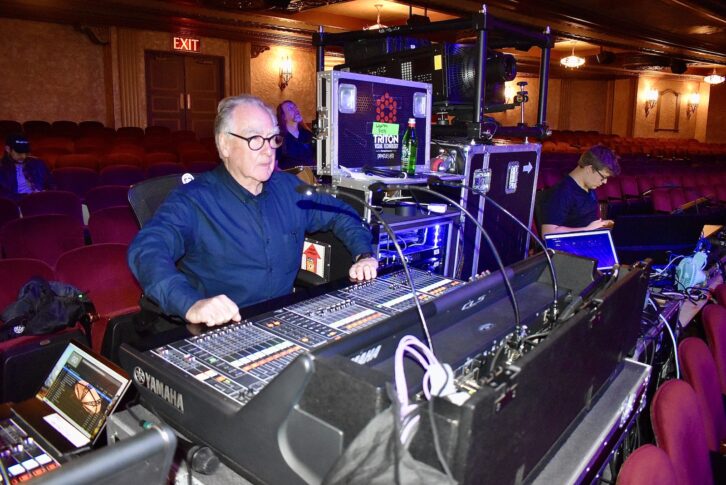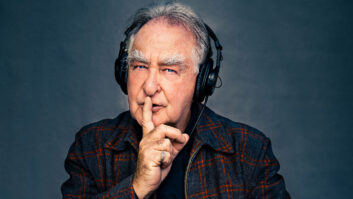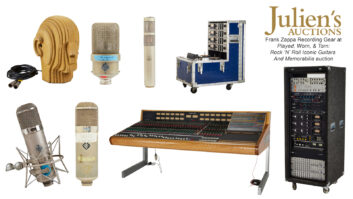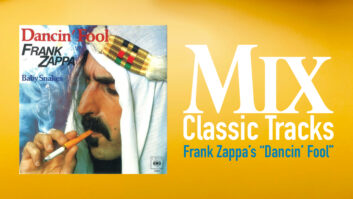
New York, NY (February 9, 2023)—Frank Gallagher has a keen ear for two things—mixing a band and telling a story—and with a resume that includes engineering Talking Heads, Simple Minds, The Go-Go’s, The Bangles, Gang of Four, Buddy Guy, Suzi Quatro, Marshall Crenshaw, Skunk Baxter and dozens more on the road, he’s done a lot of one, which has led to a lot of the other. Blessed with a wry sense of humor and a Scots accent that sounds like a sly grin, there are few things he can’t get away with saying—which may explain his longevity in the field.
“I tell bands, if you’re not giving me what I need, there’s no point in me being here— you may want to find somebody else, because I’m not going to sit here and suffer and do damage control,” said the veteran FOH engineer, speaking backstage at New York City’s Beacon Theatre during a recent stop on the B-52’s farewell tour. “This band here, I’m going to give them notes tonight on the show last night. I’m a socialist when it comes to a show—we’re all equal, we’re all in this together!”
Gallagher’s Live Sound CV is epic—there’s also stints running a hip London eatery in the Seventies, helping open and book New York’s legendary Irving Plaza in the Eighties, production managing San Francisco’s annual OysterFest for 16 years, doing corporate audio to this day and more—but in recent times, he’s added another occupation to the list: Podcast host. An offshoot of an autobiography in the works, Soundman Confidential finds him talking to old pals and acquaintances, from rockers (Vernon Reid, Davey Johnstone and virtually all the aforementioned artists) to fellow audio pros (Ed Stasium, Steve Lillywhite).
“Originally, the premise was to explore the relationship between the soundman and the band,” he said. “How does what we do get in us— because sound is in us. I remember this vividly: I was three years old, living in a little Scottish mining village. Every year, the traveling fair would come by, and that was the first loud music I heard; it had to be loud to get over the hum of the generators. The speakers were big [Altec Lansing] Voice of the Theater models and they had these Vortexion amplifiers—metal, military-grade P.A. amplifiers that looked like an ammo case and were indestructible.”
The lure of loud sounds eventually snared Gallagher for good (“I got in a van in 1966 and never got out”) and by the early 1970s, he was mixing Suzi Quatro around the world on three prototype WEM six-channel mixers daisy-chained together and WEM Festival Stacks: “Incredibly clean, and you could do 4,000 people with a couple of bins; they’d blow the ice cream outta your cone.”
Moving on to work at UK audio provider Concert Sound, Gallagher was immediately sent to start a tour in Switzerland: “They couldn’t get anyone to do it; they said, ‘Pick up these two American bands in Zurich’—and it was Ramones and Talking Heads. Ramones had a full crew; Talking Heads had no roadies, no music out in Europe, nothing. The second man on the P.A. got to mix the opener, so I set them up at the Volkshaus in Zurich, and barely got a line check. They opened the doors, the place was sold out. Talking Heads came on stage, and first song, I was busy getting a mix. Second song, I began to pay attention. Third song, the hairs on the back of my neck stood up—‘Psycho Killer? What is this?!’
“True story: I went back to the hotel after the show, barely knew them, had a wee production meeting with them. I had a cup of tea and I said to Chris and Tina and David, ‘I have no idea what’s going on here— but I want in.’ Instant decision. I don’t believe in coincidences. Fate takes a hand, but you’ve got to be smart enough to take advantage of it; I’ve never been shy about letting people know. Talking Heads brought me to New York for a couple of shows at the Entermedia Theater in New York’s East Village; by that time, they had graduated from CBGBs. We started playing up and down the Eastern seaboard, and in America, I got used to using house systems, which I did not have the luxury of in England; I was so happy!”
FRANK GALLAGHER SIDEBAR: Take Me to the Rink—The Surprise Creation of Talking Heads’ “Big Band”
The decades that followed found Gallagher moving to the U.S. permanently and honing mixing philosophies that he follows to this day:
- “I believe in keeping it simple. I tell people it’s because I’m lazy, but that’s not the truth. I’m keeping it simple because I’ve learned the less there is, the less that can go wrong.”
- “I never listen to the record. If I’ve got preconceived ideas about what’s going to come off the stage and it doesn’t meet expectations set by the record, that’s not really a good place to start. Also, I’m a realist: I have to deal with what’s coming off the stage because that’s all I have.”
- “When I go into a house these days, I don’t touch the house settings because the guy’s usually got it dialed and why would I want to reinvent the wheel? Also, I want an easy day.”
- “I don’t go over the top with effects. I’ve got one little reverb on drums and one on vocal—and if you can hear them, you’re lucky. I want it to be there without anybody knowing it’s that there, but when you take it away, you can tell.”
- “Rock and roll bands are like buses: There’ll be another one along in a minute. Once you get a couple of names on your resume, people think it means something; it doesn’t. You’re only as good as your last show.”
For the B-52’s tour, he adhered to all of those rules and more (“I don’t work for anybody with more than a two-truck tour anymore; the personalities, I don’t want to be dealing with all of that”). For the journey, he opted to mix on a Yamaha CL5 console using only onboard effects (“Never owned a Waves license”), capturing vocals on Shure wireless mics outfitted with Heil PR 30 capsules (“They give me another 10 dB before feedback over anything I’ve heard”).
The jaunt capped off a busy 2022 that saw Gallagher also mix runs with Gang of Four and Skunk Baxter, as well as tech at multiple corporate events. “Post-Covid, people are working again,” he said. “Hugo [Burnham], the drummer from Gang of Four, called and said, ‘Do you want to come out?’ I was quite enjoying being at home—Flagstaff is beautiful—and my wife said, ‘Get out of the house; go do this tour.’ And I’m not gonna say ‘my mojo,’ but my mix is back with a vengeance.”
The B-52’s tour may be over, but Gallagher will see them soon enough, helming the desk for their upcoming Vegas residencies in May and August; more runs with Baxter and Gang of Four, as well as Indian artist L. Shankar, are also in the offing. It’ll be a hectic year ahead, which suits him just fine. “I’ve lived a charmed life,” he admitted. “I’m from a little coal mining village in Scotland, got pulled in by the fairground, and had a restaurant in the middle and a dance hall in Manhattan, so I’m not afraid of anything really. Except my wife. Sometimes.”







